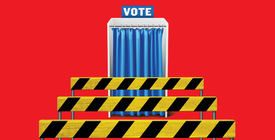In recent weeks, our colleagues have written extensively about the SAVE Act, which is currently being fast-tracked by Republicans in the House of Representatives. If it became law, the SAVE Act would require Americans to provide a birth certificate, passport, or other citizenship document to register or re-register to vote. A Brennan Center study previously showed that more than 21 million American citizens do not have easy access to these documents. An extension of our previous analysis shows that most of them are Americans who are actively engaged voters. What’s more, the SAVE Act would impact millions more voters who do have access to citizenship documents but register using popular methods, such as online and mail registration, that would be undermined by the bill.
Millions of active voters would be unable to satisfy the SAVE Act’s requirements.
While some restrictive voting policies fall disproportionately on potential voters, that’s not true of the SAVE Act. In 2023, we surveyed American citizens to determine who has ready access to their citizenship documents (meaning they would be able to produce them within 24 hours if necessary). According to that survey, roughly 64 percent of respondents who lack easy access to their citizenship documents are registered to vote, and most of them (60 percent) reported that they are “sure” they voted in the 2020 election. (For these numbers, we excluded our respondents who were under 18 at the time of the 2020 election.) Put differently, there are about 12 million American citizens who cast a ballot in 2020 but who would be functionally unable to register to vote if the SAVE Act were passed.
While these voters are already registered to vote, they would be unable to re-register if they needed to. And that’s no small risk — according to the Census Bureau, more than 12 percent of Americans move every year. Between now and the 2028 election, millions of engaged voters who lack ready access to a passport, birth certificate, or naturalization papers will move, and the SAVE Act would exclude them from future federal elections. Importantly, the effects are roughly the same across parties: 8 percent of Democrats who said they cast a ballot in 2020 don’t have easy access to these documents, compared with 7 percent of Republicans.
The SAVE Act’s impact on voter registration processes would affect tens of millions of Americans, including those who have ready access to their citizenship documents.
A huge number of American voters would be required to show their citizenship papers in person before the 2028 election if the SAVE Act became law. Americans are constantly updating their voter registrations. According to the Election Administration and Voting Survey conducted by the U.S. Election Assistance Commission, more than 91 million citizens either registered for the first time or updated their registration in the two years leading up to the 2020 election. In the two years leading up to the 2022 election, that number was 70 million. To put these numbers in perspective, at the time of the 2020 and 2022 elections, there were a little over 220 million registered voters (of whom about 90 percent were actively registered).
The SAVE Act specifies that applicants who register by mail must present their documentation in person. While the bill does not expressly address online registration or voter registration drives, those methods are typically treated like mail registration, so the bill would likewise appear to require that applicants show up in person at a government office before the voter registration deadline. That means the SAVE Act would functionally eliminate those three very popular methods of registration. According to the Election Administration and Voting Survey, more than 37 million people either registered for the first time or updated their registration using one of these methods in the two years before the 2020 election. Another 17 million did so in the two years ending with the 2022 midterms. Mail, online, and registration drives accounted for about one in three registrations over that four-year period. Just 7.7 million voters registered at an elections or registrar’s office between the 2018 and 2020 elections, and that number dropped to 4 million in the two years leading up to the 2022 midterms.
To be sure, some of the U.S. citizens who found their preferred method of registration blocked would find other ways to get on the rolls. But many others would be deterred from registering by the SAVE Act’s in-person show-your-papers requirement. The research is clear: There’s a direct relationship between the ease of registration and the number of voters on the rolls. Some American citizens — even those who can access citizenship documents — will not register, and will not turn out to vote, if they can’t register online or by mail.





